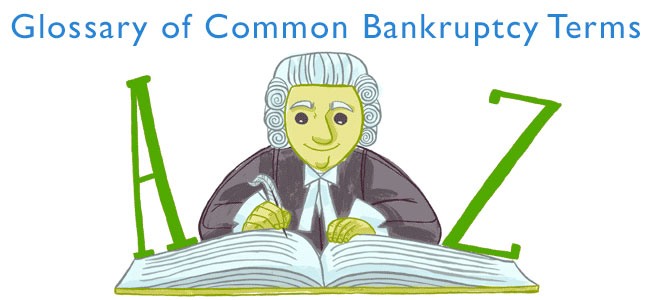Browse alphabetically:
341 Meeting: A mandatory meeting between the creditors and the debtor. Technically, such a meeting should commence within a month of the filing of bankruptcy. But often occurs later and only after the debtor files the schedules.
A
Absolute priority: The order of payment to the different types of creditors mandated by the Bankruptcy Code. As per the mandate, claimants with higher priority are paid in full before other claimants with lower priority. The statutory order is: first, administrative claims; second, statutory priority claims such as tax claims, rent claims, consumer deposits, and unpaid wages and benefits from before the filing; third, secured creditors' claims; fourth, unsecured creditors' claims and fifth, equity claims.
Acceleration clause: A clause in an agreement permitting the creditor to demand immediate payment of the debt even though the stipulated time for repayment has not yet occurred.
Adequate protection: Assurance to the creditor that they have a claim against the debtor’s assets.
Adversary proceeding: Any court case.
Assets: Any possessions that the debtor owns. They comprise both tangible assets like real estate, cars, and jewelry and intangible assets such as business goodwill; the right to sue; or stock options. The debtor must report all his assets during filing the bankruptcy schedules.
Assume a debt: An agreement where one party transfers their right to collect on a debt to another.
Automatic stay: An injunction that automatically ceases all debt collection activities, lawsuits, foreclosures, and garnishments by the creditor once the bankruptcy petition is filed.
B
Ballot date: The date on which all votes on a reorganization plan are accepted.
Bankrupt: An entity who files for bankruptcy, successfully completes the bankruptcy process and receives a discharge; a legally insolvent entity. Being a non-technical term, this is not used in the Bankruptcy Code.
Bankruptcy: A legal action for dealing with monetary liability problems of individuals and businesses.
Bankruptcy Abuse Prevention and Consumer Protection Act (BAPCPA) of 2005: Legislation that was enacted by the federal government on October 17, 2005 that primarily deals with consumer filings, thus making it harder to file for Chapter 7 bankruptcy.
Bankruptcy Act of 1898: The first permanent US bankruptcy act that gave companies the option of being protected from creditors. Also called the Nelson Act.
Bankruptcy administrator: Court officials in Alabama and North Carolina with the same responsibilities as trustees in other states.
Bankruptcy Code: The common term for Title 11 of the United States Code that governs all bankruptcy cases.
Bankruptcy court: The federal court that hears bankruptcy cases.
Bankruptcy estate: All legal or equitable assets at the time of the bankruptcy filing. The estate includes all properties in which the debtor has an interest, even if it is owned or held by another person.
Bankruptcy judge: A judicial officer of the United States district court with decision-making power over federal bankruptcy cases.
Bankruptcy mill: A business not authorized to practice law but provides bankruptcy counseling and prepares bankruptcy petitions.
Bankruptcy petition: The document filed with the court to initiate a bankruptcy proceeding.
Bar date: The last date for a creditor to file a claim against the debtor.
C
Chapter: The Bankruptcy Code is divided or organized into Chapters. The Chapters that the existing Code holds are all in odd-numbers and are enumerated with Arabic numerals. For instance, Chapters 7, 9, 11, 12, 13 and 15 cover, respectively: liquidation proceedings, municipality bankruptcy, business reorganization, family farm debt adjustment, non-business reorganization and multi-national bankruptcies.
Chapter 7: Also known as liquidation bankruptcy. Certain non-exempt assets of the debtor are liquidated in order to pay debts.
Chapter 7 trustee: The person appointed by the U.S. Trustee to oversee bankruptcy proceedings and represent the interest of the unsecured creditors.
Chapter 13: Also referred to as wage earner bankruptcy, personal bankruptcy or reorganization bankruptcy; typically reschedules individuals’ debts that is paid off within 3-5 years and also allows petitioners’ to keep property.
Claims: A creditor’s assertion of his right to receive payment from the debtor or the debtor’s estate.
Confirmation: The final consent of the bankruptcy court to a debtor’s reorganization plan. However, confirmation takes place only when the plan is approved by the creditors.
Consumer debtor: A debtor who has incurred consumer debt.
Consumer debts: Debts strictly incurred for personal causes, as opposed to business or other needs.
Contingent claim: A claim that a debtor owes under specific circumstances, e.g., if the debtor is a cosigner on another person’s loan and the person fails to pay back.
Creditor: One to whom a debtor owes money.
Credit counseling: Generally, refers to (1) the briefing that an individual must attend from a nonprofit budget and credit counseling agency prior to filing under any chapter of the Bankruptcy Code; and (2) the "instructional course in personal financial management" in chapters 7 and 13 that a bankruptcy filer must complete before the discharge order takes place.
Creditors’ meeting: A meeting that a debtor must attend in a bankruptcy case along with the bankruptcy trustee and any creditor who wish to attend. Usually, the trustee reviews the debtor’s papers and asks questions during the meeting.
Current monthly income: The average monthly income earned by a debtor over the last 6 months before the bankruptcy filing, which includes regular contributions to household expenses from non-debtors and from the petitioner’s spouse if it is a joint filing.
D
Debtor: A person or institution that owes a sum of money to someone or some institution.
Debtor education: (See credit counseling)
Default: Failure to fulfill an obligation, e.g., repayment of a loan or failure to appear in court on a given date.
Defendant: An individual or group (organization) defending a lawsuit.
Discharge: Exemption of a debtor from certain obligations those are dischargeable as per the Bankruptcy Code.
Dischargeable debt: A debt for which the debtor’s liability can be eliminated.
E
Equity: The value of a property that remains after liens and other obligations are taken into consideration. (Example: If the appraisal value of a house is #1,00,000 and is subject to a $75,000 mortgage, the equity that the house is having is $25,000.)
Exempt property: Certain properties of a debtor that the Bankruptcy Code or applicable state bankruptcy law allow to keep during bankruptcy filing and which the creditors cannot claim.
F
Fee examiner: A person appointed by the court to oversee fees paid to professionals in bankruptcy cases.
Filing fees: Fees that a bankruptcy petitioner must pay to file.
I
Insider: Any relative of the debtor or a general partner of the debtor.
Insolvency: Synonymous to bankruptcy. Technically means when an individual or organization’s liabilities exceed its assets and when the individual or the organization is unable to satisfy the same.
J
Joint administration: A court-approved motion where two or more bankruptcy cases are administered together.
L
Lien: The right to take hold or sell the property of a debtor as security or payment for a debt or other obligation.
Liquidation: Auction of the non-exempt assets of an individual or business corporation in order to pay the creditors.
M
Means test: Section 707 (b)(2) of the US Bankruptcy Code undertakes a ‘means test’ to ensure that an individual’s Chapter 7 filing is not an abuse of the Bankruptcy Code.
Motion to lift the automatic stay: A petition filed with the bankruptcy court by a creditor to allow resuming all collection activities thus putting the previously established automatic stay as null and void.
N
Nondischargeable debt: A debt that cannot be eliminated as per the Bankruptcy Code. Example: home mortgage, debts for alimony or child support, certain tax debts with the IRS, certain govt. funded education loan, and debts arising from death or personal injury caused due to reckless driving while intoxicated or under the influence of drugs.
O
Objection to dischargeability: A trustee or creditor’s objection towards a debtor’s discharge from certain personal liabilities or dischargeable debts.
Objection to exemptions: A trustee or creditor’s protest against a debtor’s efforts to claim certain assets as exempt from liquidation.
P
Party in interest: A party who has a standing to be heard by the bankruptcy court.
Personal bankruptcy: Bankruptcy filed by an individual; also called household bankruptcy, consumer bankruptcy or wage-earner bankruptcy. (See Chapter 7 and Chapter 13).
Petition: (Or, bankruptcy petition or petition for relief) the document that initiates a bankruptcy proceeding.
Petition preparer: A non-lawyer who helps debtors prepare their bankruptcy paperwork for a certain fee. A petition preparer cannot represent anyone in court or provide legal advice.
Plaintiff: A person or business that files a formal complaint with the court.
Pre-bankruptcy planning: The arrangement of a debtor’s property so that the debtor can have maximum advantage of exemptions.
Preference or preferential debt payment: Any payment made by a debtor during a certain period (90 days or a year; prior to a bankruptcy filing) that favors a creditor over others.
Priority: The Bankruptcy Code’s statutory ranking of unsecured claims that define the order according to which unsecured claims will be paid if there is insufficient cash to pay all unsecured claims. For example, money owed toward the case trustee, debt originated due to alimony or child support must be paid in full before any other unsecured debt.
Priority claims: An unsecured claim that needs to be paid ahead of other unsecured claims.
Proof of claim: A written statement with supporting documentation filed by a creditor that assist the creditor’s claim that the debtor owes the creditor money.
R
Reaffirmation agreement: An agreement by a Chapter 7 debtor to continue making payments toward a dischargeable debt even after the bankruptcy filing, chiefly for the purpose to keep the collateral that would otherwise be a subject to repossession.
S
Schedules: Detailed lists of a debtor's assets, liabilities, and other financial information filed along with the petition or shortly after it.
Secured creditor: A creditor holding a claim against a debtor and has the right to take and hold or sell certain assets of the debtor to satisfy some or the entire claim.
Secured debt: Debt supported by a mortgage, pledge of collateral, or other lien; debt for which the creditor has the right to take hold of certain collateralized property upon the debtor’s default.
Skeleton filing: A technical term used in bankruptcy courts to refer to a filing where the necessary forms are not filed.
Statement of financial affairs: A series of questions that the debtor must answer in writing, that include the debtor’s sources of income, recent transfers of property, lawsuits by creditors, etc. There is an official form that the debtor must use to describe all these details.
Statement of intention: A declaration made by a Chapter 7 petitioner regarding plans for dealing with secured debts.
Straight bankruptcy: An informal term for Chapter 7 bankruptcy or liquidation; used commonly to refer to liquidation before the Bankruptcy Reform Act of 1978.
Substantial abuse: A term that is used to refer to the abuse of the privilege to file a petition. Generally, used to describe personal bankruptcy filing frauds.
T
Transfer: Any mode or means used by a debtor to dispose his/her property.
Trustee: A representative of the bankruptcy court who exercises statutory powers, chiefly to support the unsecured creditors, under the general supervision of the court and the direct supervision of the U.S. trustee or bankruptcy administrator. The bankruptcy trustee is a private individual or corporation appointed in Chapter 7, Chapter 12, Chapter 13 and some Chapter 11 cases.
U
U.S. trustee: An officer of the United States Department of Justice responsible to oversee the administration of bankruptcy cases, estates, and trustees; controlling plans and disclosure statements; controlling creditors' committees; controlling fee applications; and assuming other statutory duties.
Undersecured claim: A debt secured by a property worth less than the total debt amount.
Unliquidated claim: A claim against which a certain value has not been decided.
Unscheduled debt: A debt that should have been listed by the debtor while filing the schedules with the court, but was not.
Unsecured claim: A claim against which a creditor holds no assurance of payment; such as a mortgage or lien.
V
Voluntary bankruptcy: Bankruptcy filed by the debtor itself.
Voluntary transfer: Transfer of the debtor’s property with the debtor’s consent.









